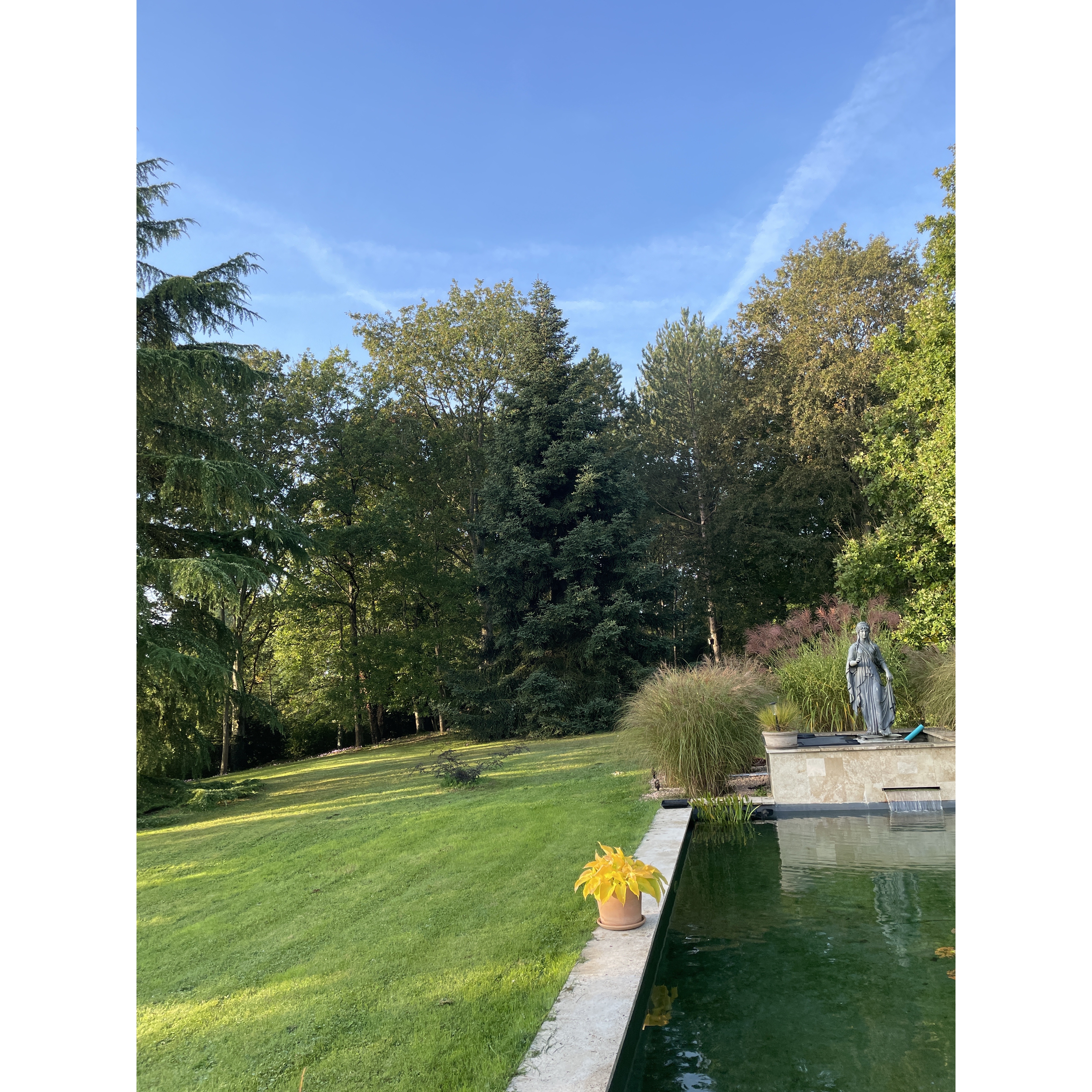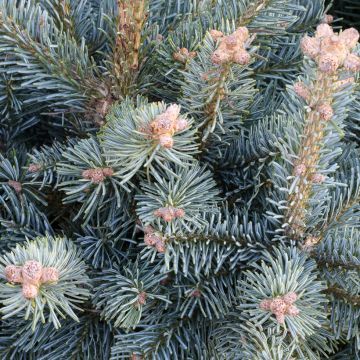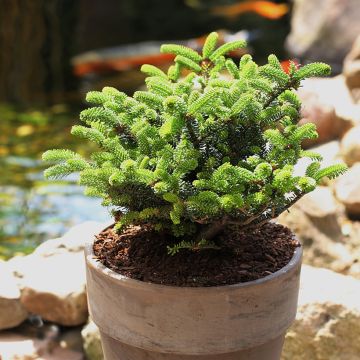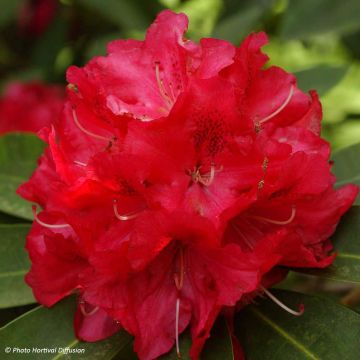

Abies nordmanniana subsp. nordmanniana Aurea - Fir
View more pictures
Hide images

Rosmarie D.

This is a 30-year-old Abies pinsapo.
Rosmarie D. • 28 FR
Abies nordmanniana subsp. nordmanniana Aurea - Fir
Abies nordmanniana Aurea
Nordmann Fir, Caucasian Fir
Special offer!
Receive a €20 voucher for any order over €90 (excluding delivery costs, credit notes, and plastic-free options)!
1- Add your favorite plants to your cart.
2- Once you have reached €90, confirm your order (you can even choose the delivery date!).
3- As soon as your order is shipped, you will receive an email containing your voucher code, valid for 3 months (90 days).
Your voucher is unique and can only be used once, for any order with a minimum value of €20, excluding delivery costs.
Can be combined with other current offers, non-divisible and non-refundable.
Why not try an alternative variety in stock?
View all →This plant carries a 24 months recovery warranty
More information
We guarantee the quality of our plants for a full growing cycle, and will replace at our expense any plant that fails to recover under normal climatic and planting conditions.
Would this plant suit my garden?
Set up your Plantfit profile →
Description
Abies pinsapo, known as Spanish fir or Andalusian fir, is an species endemic of the mountains in the south of the Iberian Peninsula and Morocco. This tall conifer is appreciated for its unique, irregular narrow pyramid habit and its very rigid golden-green needles arranged in a brush all around the branch. Slow-growing but hardy and highly drought-resistant, it is also a majestic tree that can be planted in isolation, on the boundaries of a large garden or in a container with ordinary dryish soil. This beautiful Mediterranean species thrives particularly well in dry gardens, in any well-drained even poor soil.
The Spanish fir, sometimes also called Andalusian fir, is a conifer of the Pinaceae family native to the medium and high mountains of Andalusia and Morocco. It grows in dry and warm soils but also withstands temperatures as low as -25°C (77°F). In nature, this species has a cylindrical habit that becomes flat with age, often forming several leaders. It can reach up to 25 metres (82 feet) in height. The Spanish fir is distinguished from other firs by its fairly rigid, regular and dense conical shape, which becomes cylindrical with age. Its silhouette is covered with many leafy branches about ten centimetres long. Its growth remains slow throughout its life and it remains medium-sized, not exceeding 25m (82ft). Its almost cylindrical needles, arranged in a brush and covered with a thick layer of wax, are short, 10 to 15mm (1in) long, and marked with 2 white bands on both sides, giving it an exceptional grey-blue colour. Truncated at their ends, they are very tactile. The trunk bark has a pearly grey colour that becomes fissured with age.
The 1 cm (1/2in) male cones form very decorative clusters at the ends of the lower branches, while the white-pink and slightly curved female cones, proudly point towards the sky at the top of the tree, measuring up to 10 to 15 cm (4 to 6in) in length. They turn brown when ripe and often only appear after 20 years, except in grafted specimens.
In our gardens, Abies pinsapo Aurea can reach 20m (66ft) in height and 6m (20ft) in width after many years, so it is important to consider its future growth. This tree has a straight trunk that can be cleared to facilitate circulation, and very compact branches. Its very slow growth and its particular resistance to drought and heat also allow it to be cultivated in containers on a terrace. It will find its place in any garden well exposed to the sun, with moderately poor and well-drained soil, and benefiting from good air quality as it tolerates pollution poorly. Pair it with other conifers with green or glaucous foliage, such as Juniperus communis Arnold, and Mediterranean plants like rosemary, cistus, and terebinth pistachio.
Report an error about the product description
Abies nordmanniana subsp. nordmanniana Aurea - Fir in pictures


Plant habit
Foliage
Botanical data
Abies
nordmanniana
Aurea
Pinaceae
Nordmann Fir, Caucasian Fir
Mediterranean
Other Abies
View all →Planting and care
The Abies pinsapo Aurea is best planted in autumn if the summers are warm, in a deep soil that retains some moisture, rich in humus, slightly acidic, neutral or limestone. It tolerates poor, rocky but deep soils. This conifer thrives in scorching sun or partial shade. Regularly water the young plants during the months following planting and weed the soil in summer. The Spanish fir tolerates drought once established, it is a fairly adaptable and hardy species but its bark can crack under the effect of intense frost. However, it is not suitable for regions that are too cold and humid.
Planting period
Intended location
Care
This item has not been reviewed yet - be the first to leave a review about it.
Similar products
Haven't found what you were looking for?
Hardiness is the lowest winter temperature a plant can endure without suffering serious damage or even dying. However, hardiness is affected by location (a sheltered area, such as a patio), protection (winter cover) and soil type (hardiness is improved by well-drained soil).

Photo Sharing Terms & Conditions
In order to encourage gardeners to interact and share their experiences, Promesse de fleurs offers various media enabling content to be uploaded onto its Site - in particular via the ‘Photo sharing’ module.
The User agrees to refrain from:
- Posting any content that is illegal, prejudicial, insulting, racist, inciteful to hatred, revisionist, contrary to public decency, that infringes on privacy or on the privacy rights of third parties, in particular the publicity rights of persons and goods, intellectual property rights, or the right to privacy.
- Submitting content on behalf of a third party;
- Impersonate the identity of a third party and/or publish any personal information about a third party;
In general, the User undertakes to refrain from any unethical behaviour.
All Content (in particular text, comments, files, images, photos, videos, creative works, etc.), which may be subject to property or intellectual property rights, image or other private rights, shall remain the property of the User, subject to the limited rights granted by the terms of the licence granted by Promesse de fleurs as stated below. Users are at liberty to publish or not to publish such Content on the Site, notably via the ‘Photo Sharing’ facility, and accept that this Content shall be made public and freely accessible, notably on the Internet.
Users further acknowledge, undertake to have ,and guarantee that they hold all necessary rights and permissions to publish such material on the Site, in particular with regard to the legislation in force pertaining to any privacy, property, intellectual property, image, or contractual rights, or rights of any other nature. By publishing such Content on the Site, Users acknowledge accepting full liability as publishers of the Content within the meaning of the law, and grant Promesse de fleurs, free of charge, an inclusive, worldwide licence for the said Content for the entire duration of its publication, including all reproduction, representation, up/downloading, displaying, performing, transmission, and storage rights.
Users also grant permission for their name to be linked to the Content and accept that this link may not always be made available.
By engaging in posting material, Users consent to their Content becoming automatically accessible on the Internet, in particular on other sites and/or blogs and/or web pages of the Promesse de fleurs site, including in particular social pages and the Promesse de fleurs catalogue.
Users may secure the removal of entrusted content free of charge by issuing a simple request via our contact form.
The flowering period indicated on our website applies to countries and regions located in USDA zone 8 (France, the United Kingdom, Ireland, the Netherlands, etc.)
It will vary according to where you live:
- In zones 9 to 10 (Italy, Spain, Greece, etc.), flowering will occur about 2 to 4 weeks earlier.
- In zones 6 to 7 (Germany, Poland, Slovenia, and lower mountainous regions), flowering will be delayed by 2 to 3 weeks.
- In zone 5 (Central Europe, Scandinavia), blooming will be delayed by 3 to 5 weeks.
In temperate climates, pruning of spring-flowering shrubs (forsythia, spireas, etc.) should be done just after flowering.
Pruning of summer-flowering shrubs (Indian Lilac, Perovskia, etc.) can be done in winter or spring.
In cold regions as well as with frost-sensitive plants, avoid pruning too early when severe frosts may still occur.
The planting period indicated on our website applies to countries and regions located in USDA zone 8 (France, United Kingdom, Ireland, Netherlands).
It will vary according to where you live:
- In Mediterranean zones (Marseille, Madrid, Milan, etc.), autumn and winter are the best planting periods.
- In continental zones (Strasbourg, Munich, Vienna, etc.), delay planting by 2 to 3 weeks in spring and bring it forward by 2 to 4 weeks in autumn.
- In mountainous regions (the Alps, Pyrenees, Carpathians, etc.), it is best to plant in late spring (May-June) or late summer (August-September).
The harvesting period indicated on our website applies to countries and regions in USDA zone 8 (France, England, Ireland, the Netherlands).
In colder areas (Scandinavia, Poland, Austria...) fruit and vegetable harvests are likely to be delayed by 3-4 weeks.
In warmer areas (Italy, Spain, Greece, etc.), harvesting will probably take place earlier, depending on weather conditions.
The sowing periods indicated on our website apply to countries and regions within USDA Zone 8 (France, UK, Ireland, Netherlands).
In colder areas (Scandinavia, Poland, Austria...), delay any outdoor sowing by 3-4 weeks, or sow under glass.
In warmer climes (Italy, Spain, Greece, etc.), bring outdoor sowing forward by a few weeks.















































